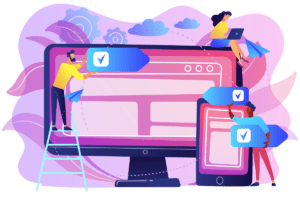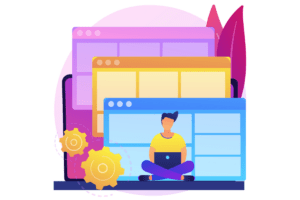Everyone is looking to improve their website conversion rate. This is oftentimes the first point of contact that you have with your prospective customers, so it’s important to make every chance count. In this article, we’re going to go through how to track website conversions, the types of conversions, and how to improve your website conversion rate. But, first let’s go over why website conversion rate is so important for marketers to track and understand.
Why is Website Conversion Rate so Important?
Website conversion rate is a metric that shows the effectiveness of your website in turning visitors into action-takers. Actions can include purchases, sign-ups, inquiries, content downloads, and more. Here are a few reasons why website conversion rates are so important to track:
- Maximizes ROI: A higher conversion rate means more of your visitors are taking desired actions, which translates to better returns on your marketing investments.
- Business Growth: Conversions are directly linked to revenue. By optimizing your conversion rate, you can increase sales without needing to attract more traffic.
- Improves User Experience: Focusing on conversion rate optimization (CRO) often involves enhancing the overall user experience, making your site more user-friendly and engaging.
- Competitive Advantage: A well-optimized website can outperform competitors by efficiently turning visitors into customers, giving you an edge in the market.
How to Track Website Conversions
There are a few different ways to track website conversions, depending on what software you actively use and what works best for your organization. Here are some of the most common ways to track website conversions.
Google Analytics
Google Analytics is the most common website analytics tool that can help you measure traffic analytics and website conversions. By setting up goals and conversions, you can see how your website is performing, where your converters are coming from, and what pages they are converting on. If you need help tracking your website conversions in Google Analytics, check out this report.
Heatmaps
Tools like Hotjar or Crazy Egg provide visual representation of where users click, scroll, and hover on your site. This can help you understand user behavior, identify potential bugs, and track conversions all in one place. Both of these tools also allow you to watch user sessions, so you can get an even better understanding of how your website visitors get to the point of conversion.
CRMs
Most CRMs like HubSpot or Salesforce can track leads and customer interactions on your website. In turn, this can provide valuable insights into conversion paths like how they were acquired, if they engaged with any emails, and help you follow up. By gaining insight into your website conversions with your CRM, you can better optimize your marketing efforts and track their touchpoints at every step of the way.
Types of Website Conversions
Conversions can take many forms, depending on your business goals and what you offer. Here are some of the most common types of website conversions.
Book a Meeting
Booking a meeting is a crucial conversion for many B2B companies and service-oriented businesses. It allows potential clients to engage in a more personal, in-depth discussion about their needs and how your solutions can address them. This type of conversion is highly valuable because it signifies a high level of interest and commitment from the prospect. To encourage visitors to book a meeting, it’s essential to have a clear and compelling call-to-action, easy scheduling options, and an accessible calendar interface that allows for quick and convenient appointment setting. Here at Visitor Queue, we use Calendly to easily book meetings.
Downloading Content
Gated content like eBooks, whitepapers, guides, research reports, and other types of valuable resources are a great way to drive website conversions. In order to download the piece of content, users must exchange their contact information. This type of conversion is beneficial because it not only positions your business as an authority in your industry but also provides valuable insights into what topics or content your audience finds most compelling. To optimize for this conversion, ensure your content is high-quality, relevant, and easily accessible through a straightforward download process. You don’t want your content to be easily searchable.
Starting a Free Trial
For SaaS businesses and other subscription-based models, starting a free trial is a significant conversion goal. Offering a free trial allows potential customers to experience your product or service first-hand without any financial commitment. This trial period is crucial for demonstrating value, building trust, and encouraging users to transition into paying customers. To enhance this conversion, make the sign-up process simple and transparent, provide ample support during the trial period, and use reminders or prompts to encourage users to explore key features of your product.
Filling Out a Contact Form
Whether it’s for inquiries, support requests, newsletter subscriptions, or feedback, contact forms are a primary way for visitors to reach out and connect with your business. To maximize this conversion, forms should be easy to find, simple to complete, and ask only for essential information to minimize barriers to submission. Additionally, clear instructions and reassurance about how the provided information will be used can help increase form completion rates.
How to Improve Your Website Conversion Rate
Now that you know what conversions to track, and how to track them, let’s go over how to improve your website conversion rate.
Personalize Your Landing Pages
Landing pages are often the first touchpoint that you have with potential customers. Because of this, you need to make a strong impression, quickly. In order to do this, you should be personalizing your landing pages. This gives each visitor a custom view of your website based on their firmographic information. This is where Visitor Queue comes in. Personalize your landing pages based on where their company is located, company size, industry, and more. For example, if a company in the SaaS industry visits your website, you could show them custom headlines, a case study, and other relevant information that helps them better understand what your company can do for them. This will not only help improve your website conversion rate, but also help speed up your sales cycle. Try website personalization for free today.
Improve Page Load Speed
A slow website can frustrate users and lead to higher bounce rates, negatively impacting your conversion rate. Fast load times are essential for keeping visitors engaged. To improve your page load speed, try optimizing large images, enable browser catching, and using fewer videos that take a long time to load. If you’re looking to improve your page load speed, try using Google Search Console. This will help you to identify areas that you can improve.
Enhance Mobile Optimization
With a significant number of website traffic coming from mobile devices, even for B2B companies, ensuring your website is mobile friendly is crucial. In turn, a good mobile experience can lead to higher conversion rates. To improve your mobile optimization, ensure that you use a responsible design that adapts to different screen sizes. Additionally, it’s important to make sure that all buttons, links, and forms are all easily used on a mobile device. Google Search Console can also help you identify areas to improve your mobile friendliness.
A/B Testing
A/B testing involves comparing two versions of a web page to see which one performs better. Regularly testing different elements of your website can reveal what works best for your audience and significantly improve conversion rates. A few things that can be tested include headlines, CTAs, and overall page layout. When you’re testing out different options, ensure that you track each option for the same amount of time. So, you can get the best results.
Optimize Forms
Forms are crucial for conversions but can be a barrier if not designed well. Optimizing forms involves making them as user-friendly and efficient as possible. Keep your forms short and only ask for essential information. Long forms can be daunting, so focus on the information you need at this stage.
What’s Next?
As you can see, there’s a lot that goes into tracking and improving your website conversions. Improving your website conversion rate is a continuous process that requires regular analysis, testing, and optimization. As I mentioned earlier, trying out different variations of your landing pages and CTAs can help you discover what your audience responds the best to. If you have any questions about using Visitor Queue to personalize your landing pages, do not hesitate to contact us.
 Identify
Identify Personalize
Personalize Benchmark
Benchmark Agencies
Agencies Integrations
Integrations Case Studies
Case Studies Use Cases
Use Cases Blog
Blog Resources
Resources









